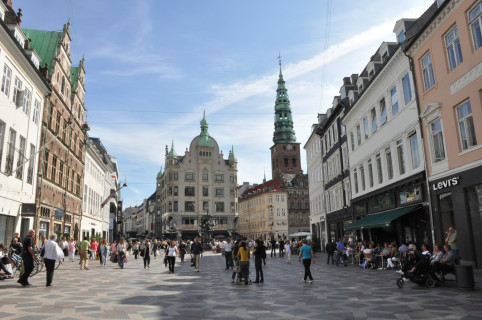How city data is transforming the way we live
8 cities show how smart data is changing the way we live. From Las Vegas to Copenhagen, smart technology is used everywhere for an efficient, safe and pleasant living environment. How exactly does smart data management work and what advantages do new technologies have for companies and the residents of the city?
1. Las Vegas: live data
Bold, brash and operating 24-hours a day, Las Vegas is a city like no other, attracting millions of visitors a year to its bustling casinos. But as well as hosting 43 million tourists each year, the city is home to almost 650,000 residents who need services including public safety, transportation and utilities. City officials recently turned to smart city data management to ease the pressure.
They used Hitachi’s Smart Spaces and Video Intelligence solution, which is a combination of hardware and software that leverages intelligent video and other internet of things (IoT) data to provide a single view of activity, operations, and safety issues with intelligence for real-time data and analysis, deploying resources more efficiently.
For example, the city can produce heat maps of streets that can indicate if a pothole is likely to develop in a given location and take steps to fix the issue before it starts to damage vehicles. Elsewhere, rubbish collection routes have been reduced from ten hours to four, redeploying employees to help with other services.
2. Seoul: smart waste solutions
With almost ten million people living in Seoul, South Korea’s capital city, waste management has become an area of focus and, as one of the most high-tech cities in the world, it’s no surprise that big data and IoT has become part of the solution.
“Ecube Labs was founded in Seoul when the first smart city projects started to emerge in Korea,” explains Guillaume Weill, project director at Intralink. “The company’s focus is on four main products, which have now been installed in more than 150 locations in Seoul, from parks to department stores, leisure venues and tourist districts.”
These include solar-powered waste bins which compact rubbish, fill-level sensors monitoring the quantity of waste in each bin, a big data platform gathering the information from the bins and a platform that automatically refines manual collection routes based on machine-learning algorithms, bringing huge cost-savings and a cleaner city.
3. Amsterdam: 3D-printed smart bridge
With its network of canals, Amsterdam has more bridges than almost any other city in the world, around 1,800 in total. But what if smart city data management meant those bridges could talk to other infrastructure to optimise travel around the city? The MX3D bridge is the world’s first 3D-printed steel bridge designed by Joris Laarman Lab in collaboration with Arup and supported by Autodesk and other partners.
Dutch firm MX3D is using industrial six-axis robots, proprietary software and welding machines that deposit stainless steel from thin, molten wire to build the 40-foot-long smart pedestrian bridge spanning the Oudezijds Achterburgwal, one of the oldest canals in Amsterdam.
Equipped with sensors, the bridge streams data to the cloud where it is then processed and interpreted to visualise intelligence about bridge traffic, structural integrity, and the surrounding neighbourhood and environment. The bridge can send alerts when it needs maintenance and can even talk to roadways to time the lights better to reduce congestion at busy times.
"Innovative solutions ensure enormous cost savings plus a cleaner city"
4. San Francisco: smart cycles
One of the strategic goals of the San Francisco Municipal Transportation Agency (SFMTA) is to prioritise transport that doesn’t involve a car. Part of its vision for a sustainable transportation system includes a safe network of bicycle-friendly streets so people of all ages and ability can feel confident travelling on two wheels.
The SFMTA uses automated counters to monitor key bicycle data, which it analyses annually to get an idea of cycle use in the city. Using the information provided by these smart monitors, the SFMTA added ten miles to the bikeway network and created thirty new intersections. Of those new miles, 5.5 received physical protection from passing traffic.
More than eight million bikes were counted at forty locations in 2018, but the data showed 63 per cent of the weekly ridership was occurring in just seventeen of the fifty-one reporting counters. This information enables the city to focus its improvement efforts where they are needed most.
5. Stratford, Ontario: perfect parking
Parking in cities is often frustrating and time consuming. But with the help of smart city data management, it can become a much simpler affair. Seeing the opportunity, the City of Stratford in Ontario, Canada, has invested in smart technology so visitors can spend less time trawling for a space and more time spending money in local businesses.
The city has installed 78 IoT sensors thatmerge information with global positioning system, or GPS, data and relay whether a parking spot is free or empty, with updates provided every half an hour to an Amazon Web Services MQTT Broker, which relays the update to the Information Builders WebFOCUS data analytics platform. WebFOCUS then creates easily read visualisations, which convey which spaces are free where, when the busiest parking periods are, and which are the preferred car parks, levels and spaces used by residents and visitors.
6. Edam-Volendam: smart lighting
With its authentic streets and charming fishing port, Edam-Volendam is a real tourist attraction. The municipality wanted to reduce the energy bill for public lighting and at the same time ensure a safe environment for visitors and residents. The smart lighting systems from Luminext in combination with LED luminaires from Lightronics and Lightwell provide the solution.
By illuminating only where it is needed and by dimming as soon as there is no traffic on the street, Edam-Volendam saves energy while ensuring a safe environment. With the smart lighting technology in the luminaires and the telemanagement system from Luminext, the public lighting network is controlled and managed remotely.
The smart lighting ensures that the amount of light is automatically adjusted to the need for light on the street. More light in dark alleys enhances the feeling of safety and dimming the street lighting in a residential area causes less light nuisance in the bedroom, which is good for a good night’s sleep. The smart lighting system automatically detects defective lamps, allowing repairs to be started quickly and to make the lighting function well as soon as possible. That also benefits street safety. The lighting installation and energy consumption are continuously monitored to be able to dim the lighting as efficiently as possible. As a result, the energy savings are optimal.
7. Copenhagen: energy saving
With dwindling global energy supplies and the environmental impact of certain types of energy, cities must look carefully at their use. It’s unsurprising then that energy use is a huge consideration when it comes to smart cities using big data.
Frederiksberg Forsyning, a publicly owned utility company in Copenhagen, aimed to create a smart energy supply solution that would optimise their supply network and create efficiency savings. One of the issues with doing this is the reliability of data, with utility companies often reliant on customers for monthly or yearly meter readings.
To tackle this, the company created a connectivity network across the municipality and then installed sensors in their pipelines to measure usage from the point of production to the substation and on to the end-customer. They went from getting infrequent customer readings to 700 data points a second, seeing savings on water loss and energy use.
8. Brussels: Smart transport tech
The Belgian capital city of Brussels relies on four metro train lines, seventeen tram lines and fifty bus lines to get its residents where they need to go. STIB–MIVB, the company that runs these services tracks 401 million journeys a year and 1,200 vehicles. To handle the stream of big data, it partnered with SAP and Cubis to access the analytics needed to improve customer service and run the system more efficiently.
As well as improving the experience of commuters and visitors, the partnership has enabled more proactive vehicle maintenance, greater transparency when it comes to use of public funds, the ability to cater for passengers with disabilities and reduced environmental impact.
“Cities are full of data that can help us better understand travel times, routes and crunch points on a network,” says Brian Duffy, SAP’s Europe, Middle East and Africa north regional president. “If used in the right way, data insights can help people get to where they are going faster, more efficiently and more reliably.”
Sources: Luminext & ‘Future Cities’; Special editen by publisher Raconteur, international distributed with The Times in june 2019.
More information at Luminext.eu or info@luminext.eu





